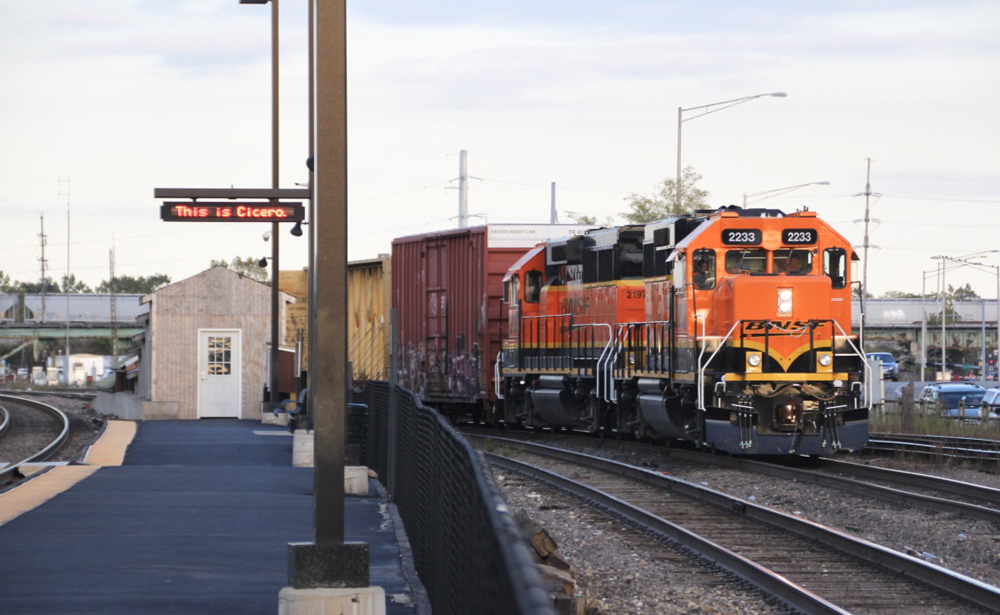
CICERO, Ill. — The back and forth between the Chicago suburb of Cicero and BNSF railway, the town’s largest landowner, over flooding and taxation continues.
The Chicago Tribune reports a state legislator is seeking to pass legislation aimed at the railroad over what the town says is neighborhood flooding caused by pavement and work to raise the profile of the land at BNSF’s railyard. Cicero filed suit against the railroad over that flooding, after the railroad sued the city over a 1,250% increase in its sewer bill [see “Illinois town, BNSF square off in lawsuits …,” Trains News Wire, July 22, 2021].
A company representative told the newspaper the railroad does not normally comment on pending legal matters but “felt compelled to provide this statement in order to respond to the false allegations made by Cicero.” BNSF said a judge recently issued a temporary restraining order against the sewer rate increase; as for the storm runoff problem, the railroad said the city has provided no photos, dates, or other evidence and only recently provided information on locations it said were affected. “BNSF has filed a motion to dismiss Cicero’s complaint and believes its allegations are without merit.”
Several residents near the BNSF yard did tell the newspaper that their basements regularly flood when it rains, but were not sure who was at fault.
In October, State Rep. Mike Zalewski introduced an amendment to a bill otherwise dealing with tenure for public officials that would require “railroads owning more than 5% of land in a municipality within the Metropolitan Water Reclamation District [to] be in conformance with the requirements of the District’s Watershed Management Ordinance.” BNSF owns 7% of the land in Cicero. At a press conference earlier this month in Cicero, Zalewski said officials “simply want the Town of Cicero and the residents affected by flooding to be protected by this ordinance,” while other officials said they were demanding that BNSF be “held accountable for flooding problems.”













While its a legal complaint by both, it is unfortunate they couldn’t work something out beyond the courtroom.
If BNSF *did* pave the entire Cicero Yard without some kind of environmental review or analysis, shame on them for not paying attention. Though I bet the City of Cicero got some very handsome fees for all those permits they had to issue.
And that is where I say shame on the City of Cicero. If they knew BNSF was going to conduct a large scale construction of any kind within the city limits, they should have held them accountable when the permits were applied for.
Not after the fact when the citizens basements are full of water.
Just remember that every type of business done with the City of Cicero requires a very green handshake.
I think the legislator would be wise to read the U.S. Constitution about “Bills of Attainder”…
I think part of the problem is that BNSF made most of its Cicero yard into an inter-model facility and paved most of it so the heavy rains run into the sewers. BNSF did not provide any detention area to reduce the impact. Before the paving, the rain could soak into the ballast and then the ground. I moved into a new subdivision in ’98 which has detention areas (required by Downers Grove) that normally are dry but when we got an inch in an hour, they would start to fill. Its outlet has a four inch restrictor to control how fast it drains.
I think the problem stems from what a lot of towns did to make things cheaper by combining sewer and storm water pipes together. I think almost all new construction the storm water is required to be separate from sewer & delt with by different rules (ponds, etc..) Thus, like a lot of older towns, the basements tend to flood when it rains too much because system is overwhelmed…Wouldn’t be surprise if this is the case here considering. I doubt that things have been measured but yes, not surprising city would go after BNSF piggybank to solve a problem that would require taxpayer dollars
..
Of course, a lot of big city or sanitary districts, like Chicago and St. Louis, with this issue are building storm water excess storage capacity by simply digging big tunnels under their cities to collect the excess runoff & store for later processing. Most of these big expenditures and corrections being driven by EPA mandates as the overflows tend to send raw sewage back into basements as well as into the nearest waterway or river for next community downriver.
Let me get this straight. The RRs have been in-place for over 100 years, but now it’s a problem that is their fault.
So did the basements flood before the RR raised their tracks out of the swamp? If properly engineered, they should have installed equalization pipes from one side of the R/W to the other to prevent any impoundments. As much as RRs dislike water under their roadbed, I can’t imagine it didn’t have any culverts when originally constructed.
So Big Al’s town wants BNSF held accountable for flooding problems that the town is not sure of what’s the exact cause? Interesting. Might be in BNSF’s favor to start monitoring their property for amounts of rainfall and runoff to save them time if the court system.